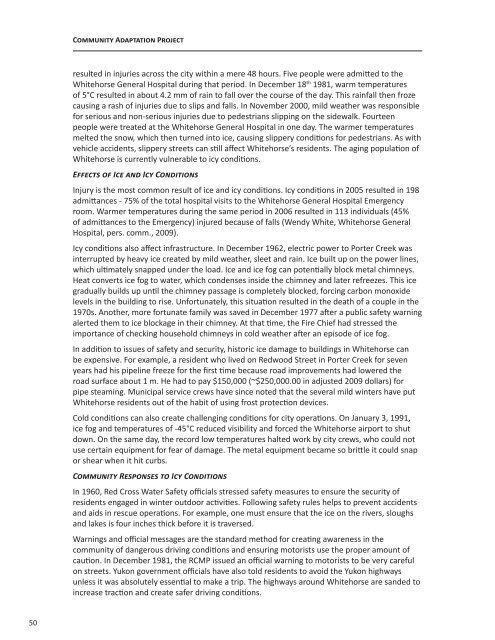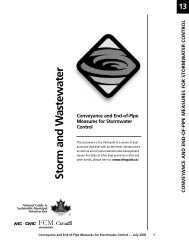Whitehorse Climate Change Adaptation Plan - Yukon College
Whitehorse Climate Change Adaptation Plan - Yukon College
Whitehorse Climate Change Adaptation Plan - Yukon College
You also want an ePaper? Increase the reach of your titles
YUMPU automatically turns print PDFs into web optimized ePapers that Google loves.
50<br />
Community <strong>Adaptation</strong> Project<br />
resulted in injuries across the city within a mere 48 hours. Five people were admitted to the<br />
<strong>Whitehorse</strong> General Hospital during that period. In December 18th 1981, warm temperatures<br />
of 5°C resulted in about 4.2 mm of rain to fall over the course of the day. This rainfall then froze<br />
causing a rash of injuries due to slips and falls. In November 2000, mild weather was responsible<br />
for serious and non-serious injuries due to pedestrians slipping on the sidewalk. Fourteen<br />
people were treated at the <strong>Whitehorse</strong> General Hospital in one day. The warmer temperatures<br />
melted the snow, which then turned into ice, causing slippery conditions for pedestrians. As with<br />
vehicle accidents, slippery streets can still affect <strong>Whitehorse</strong>’s residents. The aging population of<br />
<strong>Whitehorse</strong> is currently vulnerable to icy conditions.<br />
Effects of Ice and Icy Conditions<br />
Injury is the most common result of ice and icy conditions. Icy conditions in 2005 resulted in 198<br />
admittances - 75% of the total hospital visits to the <strong>Whitehorse</strong> General Hospital Emergency<br />
room. Warmer temperatures during the same period in 2006 resulted in 113 individuals (45%<br />
of admittances to the Emergency) injured because of falls (Wendy White, <strong>Whitehorse</strong> General<br />
Hospital, pers. comm., 2009).<br />
Icy conditions also affect infrastructure. In December 1962, electric power to Porter Creek was<br />
interrupted by heavy ice created by mild weather, sleet and rain. Ice built up on the power lines,<br />
which ultimately snapped under the load. Ice and ice fog can potentially block metal chimneys.<br />
Heat converts ice fog to water, which condenses inside the chimney and later refreezes. This ice<br />
gradually builds up until the chimney passage is completely blocked, forcing carbon monoxide<br />
levels in the building to rise. Unfortunately, this situation resulted in the death of a couple in the<br />
1970s. Another, more fortunate family was saved in December 1977 after a public safety warning<br />
alerted them to ice blockage in their chimney. At that time, the Fire Chief had stressed the<br />
importance of checking household chimneys in cold weather after an episode of ice fog.<br />
In addition to issues of safety and security, historic ice damage to buildings in <strong>Whitehorse</strong> can<br />
be expensive. For example, a resident who lived on Redwood Street in Porter Creek for seven<br />
years had his pipeline freeze for the first time because road improvements had lowered the<br />
road surface about 1 m. He had to pay $150,000 (~$250,000.00 in adjusted 2009 dollars) for<br />
pipe steaming. Municipal service crews have since noted that the several mild winters have put<br />
<strong>Whitehorse</strong> residents out of the habit of using frost protection devices.<br />
Cold conditions can also create challenging conditions for city operations. On January 3, 1991,<br />
ice fog and temperatures of -45°C reduced visibility and forced the <strong>Whitehorse</strong> airport to shut<br />
down. On the same day, the record low temperatures halted work by city crews, who could not<br />
use certain equipment for fear of damage. The metal equipment became so brittle it could snap<br />
or shear when it hit curbs.<br />
Community Responses to Icy Conditions<br />
In 1960, Red Cross Water Safety officials stressed safety measures to ensure the security of<br />
residents engaged in winter outdoor activities. Following safety rules helps to prevent accidents<br />
and aids in rescue operations. For example, one must ensure that the ice on the rivers, sloughs<br />
and lakes is four inches thick before it is traversed.<br />
Warnings and official messages are the standard method for creating awareness in the<br />
community of dangerous driving conditions and ensuring motorists use the proper amount of<br />
caution. In December 1981, the RCMP issued an official warning to motorists to be very careful<br />
on streets. <strong>Yukon</strong> government officials have also told residents to avoid the <strong>Yukon</strong> highways<br />
unless it was absolutely essential to make a trip. The highways around <strong>Whitehorse</strong> are sanded to<br />
increase traction and create safer driving conditions.

















